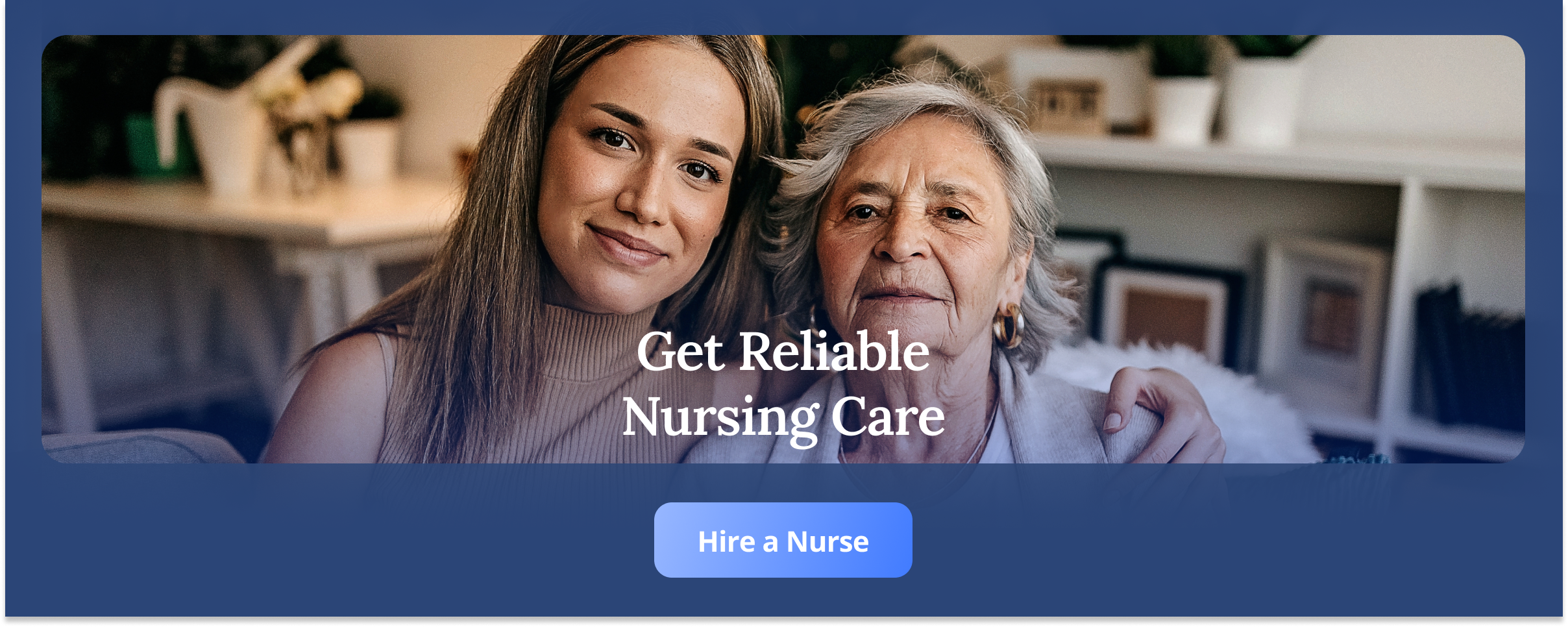After making the decision to bring a loved one home, a dizzying array of plans are set in motion.
With the pandemic, many families do not have the luxury of time for extended research and preparation, so we’ll simplify the essential tasks for you, and supply you with free planners to keep everything organized and running smoothly.
In last week’s blog post “Should Your Loved One Leave a Long-Term Care Facility?” we gave you some tools to help you make the best decision for your loved one. This week, we’re going into the planning stage.
| In This Article |
|---|
| Essential Tasks |
| 1. Understand All Medical Conditions and Treatments |
| 2. Plan Your Medical Team |
| 3. Prepare Your Home |
| 4. Get Training |
| 5. Prepare Your Family for Change |
Essential Tasks to Prepare for Extended Medical Care at Home
While planning a move home from a long-term care facility will differ for every family, we’ve found these five steps are the most critical in ensuring a smooth transition and excellent medical care.
- Understand All Medical Conditions and Treatments
- Plan Your Medical Team
- Prepare Your Home
- Get Training
- Prepare Your Family for Change
1. Understand All Medical Conditions and Treatments
IN THIS ARTICLE
The decision to bring your loved one home will not be the last decision you’ll have to make.
Along the way, you’ll be fielding questions from medical professionals and finding yourself in conversations with seemingly more Latin words than English.
The sooner you start researching and learning, the easier the process will be for you.
As you find valuable resources, keep track of them for future reference. Nothing is worse than trying to backtrack through your search to find a needle in the haystack of content. You can copy this Research Tracker and start reading and learning.
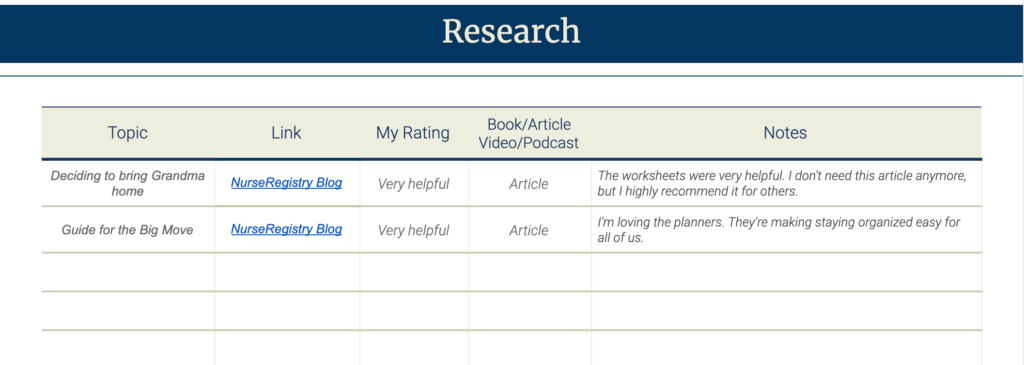
If you completed the Care Calendar, you will already have a glimpse of your loved one’s medical conditions and needs. Now, if you’re responsible for their care, you will need to learn more and in greater depth.
- Medical Conditions. Make sure you know of all medical conditions, including those that may have arisen more recently. Then, start reading up on them, their symptoms, and treatment options. Here is a Medical Conditions Chart you can use.

- Allergies. Find out if your loved one has developed any new sensitivities. If so, make sure all members of the household have committed the list to memory, and post an Allergies Chart like this one, in a visible location.

- Medications. Not only do you need to know what medications are being taken and when, but you’ll also need to be aware of the possible side effects and interactions between different ones. Use this Medications Chart to keep track.
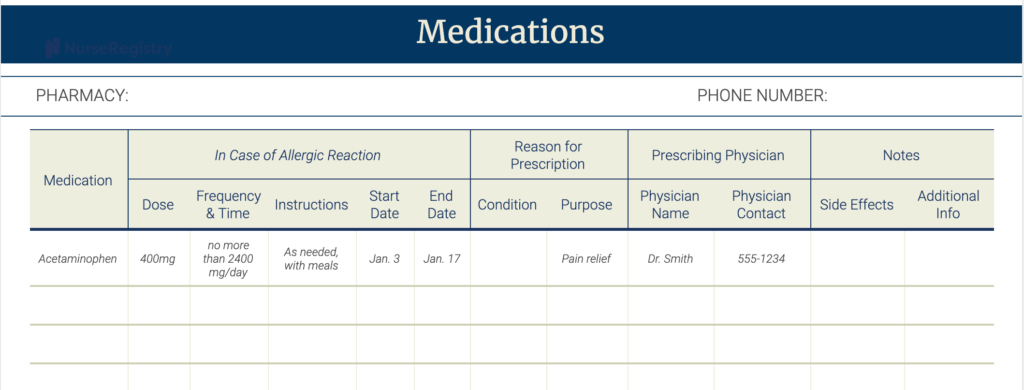
- Dietary Restrictions. Request your loved one’s dietary restrictions from the long-term care facility in advance, so you can prepare or train your caregiver accordingly.
Get home faster
Before you bring your loved one home, complete the Care Calendar, Medical Conditions, Allergies, Medications Sheets, and Dietary Restrictions sheets. If they use a wheelchair, discover the best wheelchair care tips.
Later, you can continue reading about care tips, research, and treatments.
Research Organizers
- Medical Conditions Worksheet Template (Google Docs)
- Allergies Info Template (Google Docs)
- Medications Info Template (Google Docs)
- Dietary Restrictions Template (Google Docs)
- Research Resources Template (Google Docs)
Comprehensive Home Care Planner (Google Sheets)
Comprehensive Home Care Planner (PDF)

2. Plan Your Medical Team
Taking care of your loved one will involve many layers of care. You’ll want to know exactly which healthcare professionals to call and when, before your loved one comes home.
As you put together your home health care plan, this step may be the most critical for superior medical care.
Keeping track of all the physicians, nursing teams, and support resources in one place that is easily accessible for all members of the family will make all the difference for continuous care and peace of mind.
Team Leader
You will need someone to coordinate all efforts and be prepared to deal with daily medical needs.
The team leader may be you, a family member, a private nurse, or a specialized care manager.
Care managers, like Sage Eldercare Solutions or The LifeCare Company (TLC), have extensive experience managing the healthcare needs of longterm patients, along with it tremendous resources at their fingertips.
Enlisting their expertise means better healthcare and peace of mind for everyone (and more free time for your family to spend together). Aging Life Care Association (ALCA) provides a searchable directory of all their care manager members.
For some patients whose medical needs are simple, families ask if there is a middle ground between signing with a professional care manager and doing everything on their own.
The solution for these situations is hiring a private nurse to care for the patient and manage all the moving parts: scheduling medical appointments; accompanying your loved one to doctor appointments, physical therapists, and other healthcare professionals; managing medications; ordering medical supplies; etc.
Physicians
In a skilled nursing facility, patients are under the care and supervision of a physician.
Your loved ones will need a new physician to oversee healthcare which may range from a primary care physician and/or gerontologist to various specialists.
A growing trend in-home care is concierge physicians who make house calls. They’re providing accessible quality healthcare for patients whose mobility is not easily managed and for families a sense of relief.
Tracking all of a patient’s doctors can be tricky, it will be good to that figured out before the move.

Nurses
A patient is often referred to a skilled nursing facility because they require skilled nursing care.
For the majority of cases, the hours of skilled nursing that each resident receives on a daily basis is limited, with assistance primarily provided by caregivers.
Is it possible to hire a private nurse to come to your home for weekly, daily, or 24/7 care? Resoundingly, yes.
You can even hire a nurse to visit your loved one in an assisted living residence, or even go along on family vacations.
As you’re searching for nurses, you do need to know whether your loved one needs a registered nurse (RN), or a licensed vocational nurse (LVN).
Registered nurses can do everything an LVN can plus infusions and more advanced interventions. So the simplest question to ask is “Does your loved one need infusions?” If you answered yes, then you want to make sure there is an RN in your nursing care team.
As you put together your home health care plan, you may want both RNs and LVNs on the nursing care team.
The single most helpful worksheet for making a nurse care plan is the Care Calendar from last week’s article.
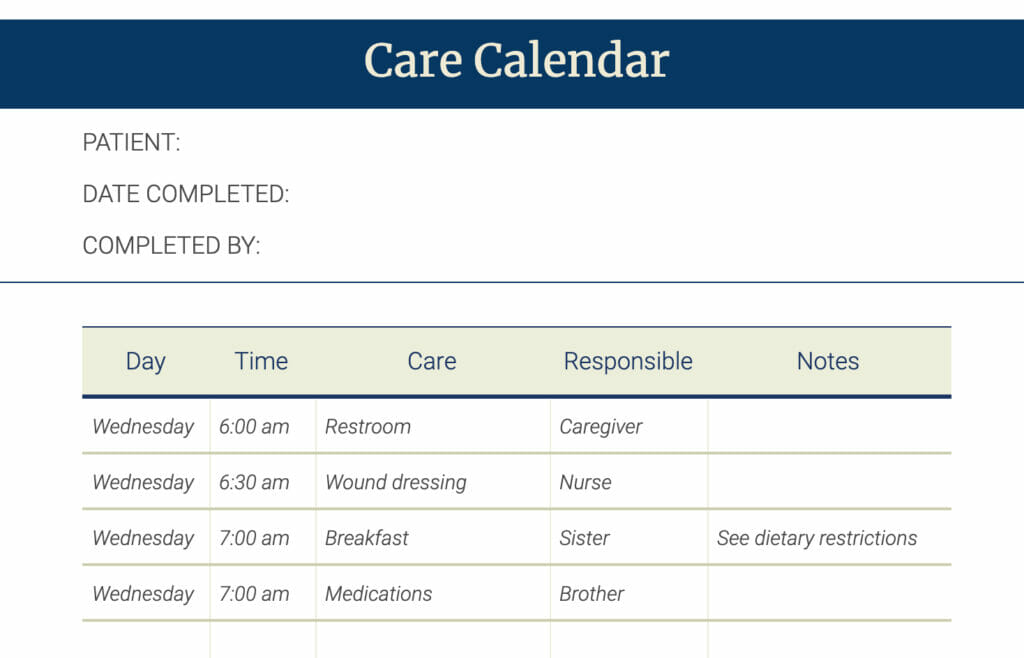
Whether you completed it on your own or retrieved it from the long-term care facility, with a planner like the one in the example above, you’ll be fully equipped to answer any questions and schedule nurses.
Caregivers
Caregivers take care of your loved one’s personal needs, like eating, bathing, dressing, and basic housekeeping like cooking and laundry. They do not provide medical support.
While caregivers and CNAs (Certified Nursing Assistants) can provide medication reminders, basic medical needs—such as pre-filling medisets—can only be done by an LVN or RN.
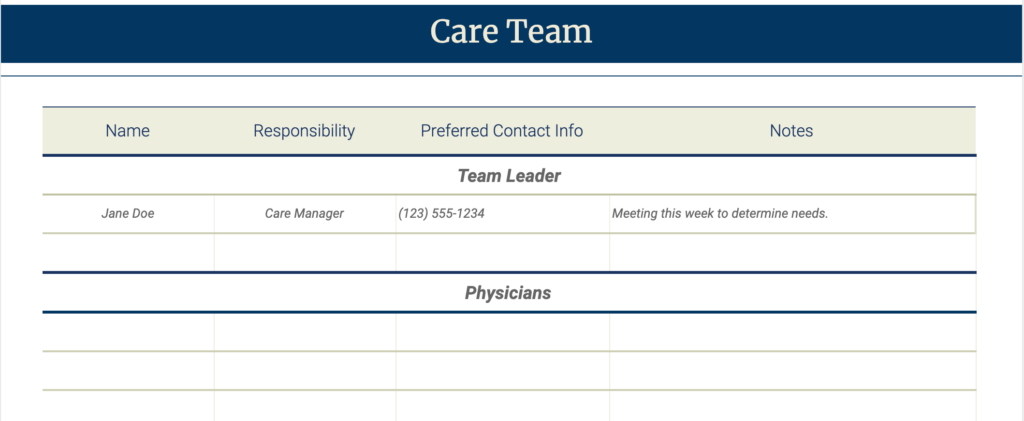
Get home faster
Preparing the medical care team, must be done before you bring your loved one home.
Medical Team Organizer
- Care Team Template (Google Docs)
- Comprehensive Home Care Planner (Google Sheets)
- Comprehensive Home Care Planner (PDF)
3. Prepare Your Home
You may need some adjustments to your home to make it safer for your loved one or to make it easier for them to get around independently which will go a long for their own morale and the whole family’s peace of mind. If your loved one is in a wheelchair, make sure they are receiving the proper wheelchair care and accessibility they need.
The first step is to complete an assessment of your loved one’s needs. You may have already done the assessment while deciding whether or not moving home is feasible. In this case, simply take out the list and start working through it. If you need to make any major changes or rent a hospital bed or wheelchair ramp, checkout this list of stores for medical supplies and equipment.
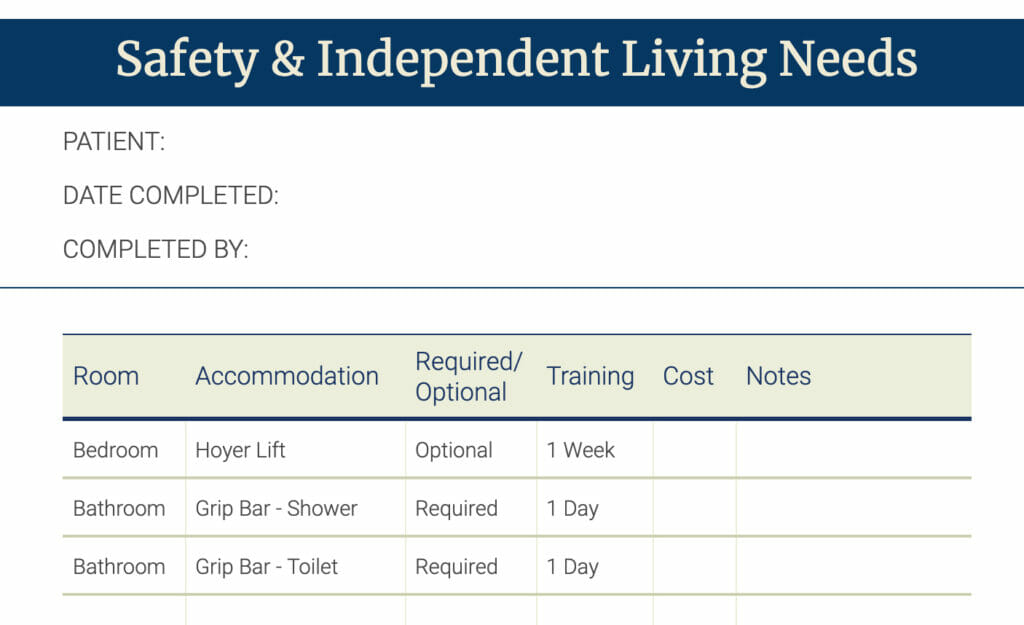
If you haven’t completed a worksheet like the above sample, see the previous article in this series.
Contacts and Resources
We never know when an emergency will arise. Before you bring a loved one home, gather all resources and emergency contacts in a place that all family members, nurses, and caregivers can access (both online and print).
You’ll want to have primary contact information and a backup plan, for each of the following:
- Physicians
- Nurses
- Caregivers
- Pharmacies
- Transportation
Depending on your family’s needs, there may be other contact information you’ll want to include.
Power Outages
If your loved one uses devices or equipment that run on electricity, whether for medical and independent living needs, apply for the PG&E Medical Baseline Program. Note: The signature from a medical practitioner is temporarily waived due to the COVID-19 pandemic.
During a power outage, you can seek support from a nearby Independent Living Center collaborating with PG&E.
Get Home Faster
If your time is limited, here is the order of precedence when making installations.
- Complete all installations that are listed as necessary in the Safety Needs Sheet.
- If you have time, install those that can be a nuisance for a loved one if installed after their arrival.
- If you have enough time, you can finish the preferred accommodations as well.
Once you’re loved one moves in, together you can find ways to make your home safer and more comfortable.
Safety and Independent Living Needs Worksheet
- Safety Needs Template (Google Docs)
- Comprehensive Home Care Planner (Google Sheets)
- Comprehensive Home Care Planner (PDF)
4. Get Training
So much is new and requires training, beyond basic CPR and first aid. Start taking courses and learning online as soon as possible.
Because it can be a large time drain, many families hire a nurse to come in and give the family dedicated instruction and training.
At NurseRegistry, these are the six most common reasons that nurses are requested for training:
- Bowel Program
- Hip Replacement & Safe Movement
- Home Dialysis
- Straight Catheter
- Hoyer Lift
- Caregiver Training
While these are the most common, the list of medical instruction and training that nurses can provide is seemingly endless.
If you’re hiring a nurse for private training, the training can begin the moment you pick your loved one up from the long-term care facility. The nurse may accompany you home during the move and begin training immediately with repeat visits until everything is running smoothly.
Get Home Faster
Prepare the list of training needs before your loved one moves home, but much of the training will take place during the first few weeks.
Training Organizer
- Training Organizer (Google Docs)
- Comprehensive Home Care Planner (Google Sheets)
- Comprehensive Home Care Planner (PDF)
5. Prepare Your Family for Change
With the rush to get everything done on time, it’s tempting to postpone updating everyone who may be affected until you’ve “figured it all out.” Keeping them in the loop early on, will help you and them adjust.
Whether you are working with a short timeline or not, involve members of your household in the planning. Not only will they be better prepared to help later on, but they’ll have a better appreciation for the time and effort required.
Most importantly, an active role in planning helps people transition to a new life at home.
As we mentioned in the last article, you’ll need to have support systems in place for when your family needs respite.
If you’re setting aside time to talk about the progress made in planning, continue to use that time after move-in to keep tabs on each other.
Get home faster
Work together with your household members to plan and prep.
Conclusion
We hope sharing these templates and sample charts helps you get organized and provide the best possible care for your loved one.
We know there are many sheets to complete, you can use this checklist to make sure you got them all. The checklist is also the first page in the Google Sheets file and the PDF.
For all Google Docs and Google Sheets, make a copy of the file for yourself, so you can get started.
If you have any questions, please call us at (866) 916-8773 any time.
